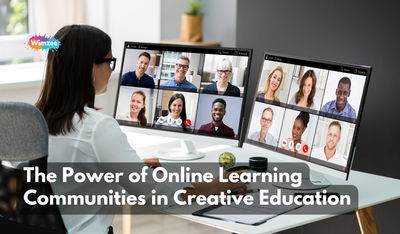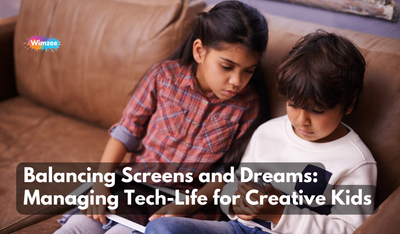In the digital age, online learning communities are becoming a game changer in the field of creative education. These vibrant digital arenas are not just about bridging distances but are fostering a new era of learning where creativity meets technology. From engaging young minds in interactive environments to connecting them with seasoned creatives, these platforms offer a plethora of opportunities to enhance education dynamically.
Understanding Online Learning Communities
An online learning community is essentially a dynamic digital space where members engage in peer-to-peer learning, utilizing various online communication methods like social media, video conferencing, and forums. These communities are structured around shared learning goals, where both novices and experts can exchange knowledge, ideas, and resources in a supportive environment (Teach.io).
The Structure of Online Learning Communities
The backbone of these communities is their ability to bring together diverse individuals who are eager to learn and share. This structure is often supported by technological tools that facilitate easy and effective communication. For instance, platforms may offer features like real-time chat rooms, dedicated discussion boards, and collaborative project tools, which are essential for fostering a sense of community and collaboration (Wikipedia).
How Technology Enhances Learning Communities
Technology plays a crucial role in online learning communities by providing the tools necessary for creating collaborative and engaging educational spaces. Video conferencing software like Zoom, social media groups on platforms like Facebook, and instant messaging tools such as Slack or WhatsApp are just a few examples of how technology can enhance the learning experience. These tools make it possible for users to maintain social presence and cognitive presence, which are critical for a successful online learning community.
Social Presence
Social presence in an online learning community refers to the ability of participants to project their personal characteristics into the community, thereby making themselves known as 'real people'. This presence supports group cohesion and collaboration, which are vital for a vibrant learning environment. It enables participants to build meaningful relationships with one another, despite the lack of physical interaction (Thinkific).
Cognitive Presence
Cognitive presence, on the other hand, focuses on the intellectual and reflective aspects of learning within the community. It encompasses the exploration of complex problems, the integration of new knowledge, and the application of concepts in real-world situations. This element ensures that the learning is not only interactive but also deeply engaging and intellectually stimulating.
The Benefits of Building Online Learning Communities
Creating an online learning community can significantly enhance educational experiences by making learning more interactive and accessible. It provides a platform for continuous learning and interaction among students and experts from various fields, thus broadening educational horizons and fostering professional growth. Additionally, these communities can serve as a critical resource for networking, mentorship, and career development.
In summary, online learning communities harness the power of digital tools to create spaces that are not just about learning but also about growing together. They blend the educational with the social, making learning a more comprehensive and enriching experience.
Benefits of Online Communities in Creative Education
Online learning communities are redefining the landscape of creative education by offering personalized learning experiences that cater to diverse intelligences. These digital platforms not only accommodate various learning styles but also integrate advanced educational technologies to create dynamic and interactive learning environments (Harvard Business School Online).
Personalized Learning Experiences
The core advantage of online learning communities in creative education is their ability to provide tailored learning experiences. These platforms use adaptive learning technologies that adjust content and pace according to individual learner needs, ensuring that each student can learn in a way that best suits their unique cognitive styles and intelligence types. This personalized approach helps in nurturing creativity and innovation, as learners are not bound by a one-size-fits-all curriculum (Learning Liftoff).
Peer Interaction and Mentorship
Another significant benefit is the vibrant interaction between peers and the availability of mentorship from professional creatives. Online communities connect learners with experts and seasoned professionals, offering mentorship opportunities that are often unavailable in traditional learning settings. This access not only enhances learning but also provides vital industry insights and networking opportunities. For instance, students might collaborate on projects with peers globally, gaining exposure to diverse perspectives and practices .
Success Stories: Impact of Online Learning Platforms
Many online learning platforms have shown considerable success in enhancing creative education. Platforms like Coursera and Udemy offer courses in diverse creative fields ranging from graphic design to music production, facilitated by experts in those areas. These platforms not only provide access to top-tier educational resources but also include community features that allow learners to interact with instructors and fellow students, enriching the learning experience by fostering a sense of community and collaboration.
By integrating personalized learning, interactive peer communities, and expert mentorship, online learning communities are playing a pivotal role in advancing creative education. These platforms not only make learning more accessible and flexible but also enhance the educational journey by connecting learners with a global network of creatives, ultimately fostering a more collaborative and enriched learning environment.
Interactive Learning Environments for Kids
Interactive learning environments (ILEs) are revolutionizing the way kids engage with education, tailoring experiences to their specific learning styles, such as verbal-linguistic or musical-rhythmic intelligences. By integrating multimedia tools and interactive strategies, these environments significantly enhance the engagement and learning outcomes for children.
Catering to Diverse Learning Styles
Interactive learning environments are adept at meeting the varied educational needs of children by incorporating activities that cater to different learning styles. For instance, for kids with verbal-linguistic intelligence, platforms like Khan Academy use video lectures that break down complex topics into manageable parts, enhancing comprehension and retention. Similarly, for those with musical-rhythmic intelligence, digital platforms may integrate music and sound to aid learning, which can be particularly engaging and effective in maintaining students' interest and improving memory (MDPI).
The Role of Multimedia and Tools
The use of multimedia in learning environments provides dynamic ways to present information that keeps young learners captivated. Tools such as EduClipper and ClassDojo offer platforms where students can showcase their creative assignments, engage in interactive sessions, and receive real-time feedback from educators. This not only enhances their understanding but also boosts their confidence and communication skills. Additionally, technologies like Jupyter notebooks in platforms like IllumiDesk allow for integration of live code, visualizations, and explanatory text, making learning more interactive and practical.
Effective Case Studies
Case studies highlight the effectiveness of these environments in real settings. For example, dialogic literary gatherings (DLGs) and interactive groups (IGs) have shown promising results in inclusive settings, where they enhance comprehension and foster prosocial behaviors among students. These gatherings involve students discussing and reflecting on texts they have read, which improves their analytical skills and emotional intelligence. The benefits are observed not just in learning outcomes but also in developing key social skills and deeper understanding of peer perspectives (MDPI).
Interactive learning environments are not just about integrating technology into education; they are about transforming it into a lively, engaging, and inclusive experience that adapts to the needs of all learners, making education a joy rather than a chore.
Challenges and Solutions in Online Learning Communities
Identifying Common Challenges
Online learning communities face a spectrum of challenges that can hinder their effectiveness and impact. Key issues include:
- Internet Access and Technical Barriers: The digital divide remains a significant challenge, with some learners in remote or underprivileged areas struggling to access reliable internet. This problem is exacerbated by compatibility issues across different devices and operating systems, which can affect the delivery and experience of online learning.
- Lack of Personal Interaction: Virtual platforms often struggle to replicate the personal interaction and engagement found in traditional classrooms. This can lead to decreased student participation and engagement, crucial elements that are often diminished in a purely online setting.
- Time Management and Distractions: Online learners frequently battle distractions at home and find it challenging to manage their time effectively. This can lead to procrastination and a lack of discipline in keeping up with course requirements (Thinkific).
- Accessibility Issues: Ensuring that learning materials are accessible to all, including those with disabilities, is a critical challenge. Many online platforms need to better support diverse learning needs, such as offering captions or audio descriptions for those who require them.
Strategies for Overcoming These Challenges
To address these widespread challenges, online learning communities can implement several strategies:
- Enhancing Technological Infrastructure: To combat issues of internet access and compatibility, educational platforms can optimize content for low bandwidth situations and ensure cross-device compatibility. Providing technological support and resources can also help bridge the gap for less tech-savvy learners (Big Think).
- Fostering Interaction and Engagement: Creating more opportunities for interaction within online courses is vital. This can be achieved through live discussions, group projects, and interactive sessions that encourage active participation. Incorporating elements of gamification can also increase engagement and motivation.
- Improving Time Management Supports: Offering structured schedules with built-in breaks and modular learning segments can help learners manage their time more effectively. Additionally, providing clear guidelines and check-ins can aid students in staying on track.
- Prioritizing Accessibility: Ensuring that all learning materials are accessible is crucial. This includes providing audio descriptions, subtitles, and designing content that is easy to navigate for people with various disabilities. Regularly updating content to meet accessibility standards is also essential.
Enhancing Creative Education Platforms
Implementing these solutions not only addresses the immediate challenges but also enhances the overall effectiveness of creative education platforms. By improving accessibility, engagement, and support, online learning communities can become more inclusive and dynamic. This creates an environment where all learners, regardless of their background or physical abilities, have equal opportunities to thrive and succeed.




